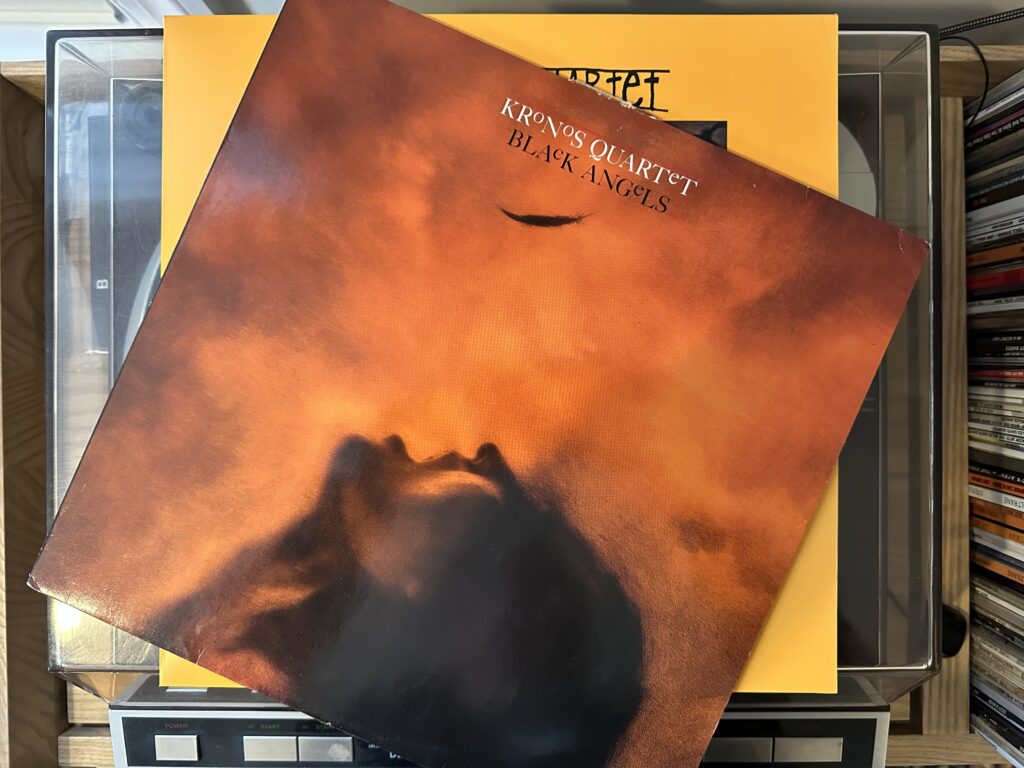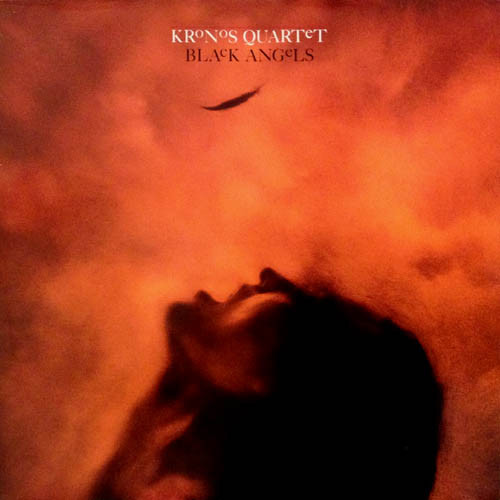
Album of the Week, March 11, 2023
I’ve written about my experience finding Black Angels before, in the year of the 30th anniversary of the release of the album. Everything about what I wrote then remains true now: the searing intensity of the performances, the indelible impression it made on my memory. But how did Kronos get into the place where they made this recording?
It starts with the title piece. David Harrington has said that a 1973 performance of George Crumb’s quartet in protest of the Vietnam War was his inspiration to found Kronos, and you can hear his love for the work in the intensity of the performance. You can also hear something else: the degree of studio engineering it took to realize the experience. “Black Angels” features amplified string instruments, a gong and other percussion instruments as well as chanting and other sounds, and the recording brings all the unusual sound to the fore and, well, beats the listener about the head and shoulder with it. It’s inescapable and haunting, and the quiet opening of the middle movement is as powerfully contemplative as anything on record. The middle movement also features the chanted “Ein, zwei, drei, veir” (here pronounced fear) and a moment of contemplative requiem performed by the lower strings, with the high strings sounding horror-movie scratches above. The final movement features the “God music” in which the quartet is joined by music from crystal glasses.
Which makes the transition into the next work, a studio version of Thomas Tallis’s 40-part motet “Spem in Alium” rearranged for overdubbed string quartet, slightly less bewildering than it appears on paper. I talked a lot with singer friends about this performance when I was in college; the concept of a string quartet playing 40 different parts from one massive score was as novel to us as, I suspect, the existence of the motet itself. (I grew up on classical radio, but even our relatively cerebral channels WGH (and subsequently WHRO) played very little repertoire that was older than Bach.)
Is the Kronos adaptation of the motet successful? I’d have to say it’s mixed. Certainly the depth of sound from the overdubbed strings is powerful, but nowhere near as impactful as a performance with choir. The studio magic that Kronos employed did not extend to creating the spatial illusion of being surrounded in a cathedral with eight vocal quintets, which is much of the “shock and awe” of the original motet. But it does powerfully convey the sense of colossal loss that seems to underlie so many of Tallis’s works, as a crypto-Catholic at the court of the King of England.
“Doom. A Sigh” is in another space entirely, but maintains the thread of lament. Here the quartet seems to play mostly ambient or electrically amplified sounds, accompanying field recordings of folk songs from Hungary made by the composer István Márta that speak of the loss of the nation’s traditions under Communist rule.
The performance on Black Angels rarely lapses into irony, which makes the one exception, Charles Ives’ “They Are There!,” all the more striking. Accompanying a recording of Ives playing and singing his own composition, the effect of the piece appears to be to skewer the patriotism of the call to war that appears in the text of the work. One interpretation is that Ives, a pacifist, could “get fightin’ mad about his pacifism.” As a teenager coming out of the Reagan years of the Cold War, I tended to interpret Ives’ performance, recorded during the height of World War II, through a heavy lens of irony, keenly aware as I was of the cost of the massive military machine that kept the state of war simmering for more than forty years. Now that we know the cost of the fascism that the troops were fighting at the time, and have seen its resurgence in the last ten years, the ironic reading feels less true for me.
The record closes with a performance of the Shostakovich String Quartet No. 8, which has been variously interpreted as being dedicated to the victims of fascism (a dedication endorsed and perhaps applied by the official Soviet regime on the quartet’s publication in 1960) and to an overwhelmed soul who contemplated suicide. The work pulls together all the threads from the other works, including threnodic passages that point back (forward?) to “Black Angels,” the requiem-like sadness of the opening movement, and an overwhelming sense of dread and loss.
The overall impact of Black Angels can be overwhelming, but it is highly recommended. After several albums of commissioned works, it earned the quartet many awards and nominations, and put Kronos firmly on the map as an essential, innovative ensemble, a reputation that the quartet would continue to re-earn through the following decade. That’s especially true with the album that we’ll review next week.
You can listen to the album here:

